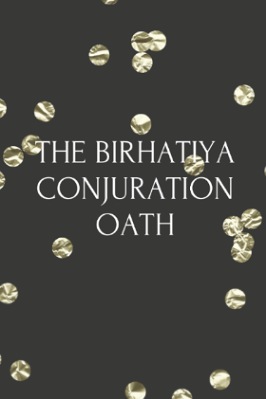
| Book Title | The Birhatiya Conjuration Oath And The Meaning Of Its First 28 Names |
| Book Author | |
| Total Pages | 15 |
| Book Views | |
| Language | English |
| Book Download | PDF Direct Download Link |
| Get Hardcover | Click for Hard Similar Copy from Amazon |
The Birhatiya Conjuration Oath and the meaning of its first 28 names by N Wahid Azal
The Birhatiya Conjuration Oath and the meaning of its first 28 names
The recitation of our translation here was first delivered as part of our presentation on the occasion of the third Alternative Expressions of the Numinous conference held at the University of Queensland in Brisbane, Australia, in mid August 2008.
The meanings were translated just before the
commencement of Ramadan 1429 (August 31, 2008).
Together with the two Jaljalutiya poems ( major a and minora ) attributed to the first Shii Imam c Ali ibn Abi Talib (d. 66l), as well as the 40 Idrisid Names,
the Birhatiya conjuration oath constitutes one of the preeminent magical proof-texts and
invocations among the vast occult ruhaniya/ ulum ghariba literature of the Islamic world
It especially occupies a pride of place amongst the Corpus Bunianum, and so,
therefore, no discussion of the subject can proceed objectively without some reference to it.
Many versions of the text exist in manuscript as well as in the printed editions, sometimes with variations between the names as well as in the structure of the conjuration oath itself.
The standard, popular recension and discussion of it, however, remains the one elaborated by al-Bunl, particularly in the commentary reproduced in the Wellspring Sources of Wisdom ( manba c usul al-hikma ) (Beirut, n.d.).
Although this conjuration oath (or, rather, its names) has appeared and been discussed in an endless array of ruhani/ c ulum ghariba related material in Arabic, Persian, Urdu, Javanese, Gujarati (and even Albanian), to name a few, its origin remains somewhat shrouded in obscurity and so to a great extent conjectural as to specific origin.
Al-Bunl attributes a pedigree originating in distant antiquity and a provenance chiefly going back to the era of the Biblical-Quranic prophet-king Solomon.
Prior to al-Banu treatment of it, the Birhatiya was also dealt with in depth by two currently unknown Muslim occultists in the centuries immediately prior to al-Bunfs, viz. Muhammad ibn Ahmad al-Tabs! (d. 1089/90) 7 and Ibn Arfa c Ra’s (d. 1197).
Each of their quite detailed discussions of the subject (and especially the names) still remain only in MSS and are presently being studied.
Much like the Greco-Egyptian magical papyri, the interest of this text to serious students of white magic and the occult in the Islamic world is in its deliberate (and to a great extent,
creative) linguistic syncretism which utilizes divine names in Hebrew and Syriac within the general context of an Arabic invocation
incorporating Quranic quotations specifically directed at invoking helper jinn, angels, spirit guardians (i.e. muwwakilun) — and as some have asserted, also helper demons ( c afarit ) — all of which are held to be the instantiations of these (pseudo-) Hebreo-Syriac names.
Discussions of it have been provided by Tewfik Canaan in his article “The Decipherment of Arabic Talismans” and more recently in two popularized discussions (one book length) by Nineveh Shadrach.
While many modern scholars would consider such words and those names associated with the Birhatiya to be outright gibberish;
it must be underscored and emphasized that to occultists in the Islamic world they are not.
Such names and words, even if contrived to some degree by the standards of language and precise philology
To read more about the The Birhatiya Conjuration Oath And The Meaning Of Its First 28 Names book Click the download button below to get it for free
Report broken link
Support this Website
Click here to join our Telegram group for new Books